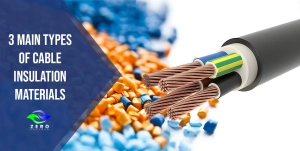

What Is PVC?
PVC is a type of plastic that is produced from chloroaliphatic hydrocarbons. It has important physical and chemical properties, including resistance to heat, flame, corrosion and atmospheric effects. This plastic is used as one of the widely used plastic materials in various industries such as automotive, construction, electronics, clothing, etc. In addition, PVC is recognized as a sustainable and green material in the plastics industry due to its ability to be recycled and returned to its life cycle.
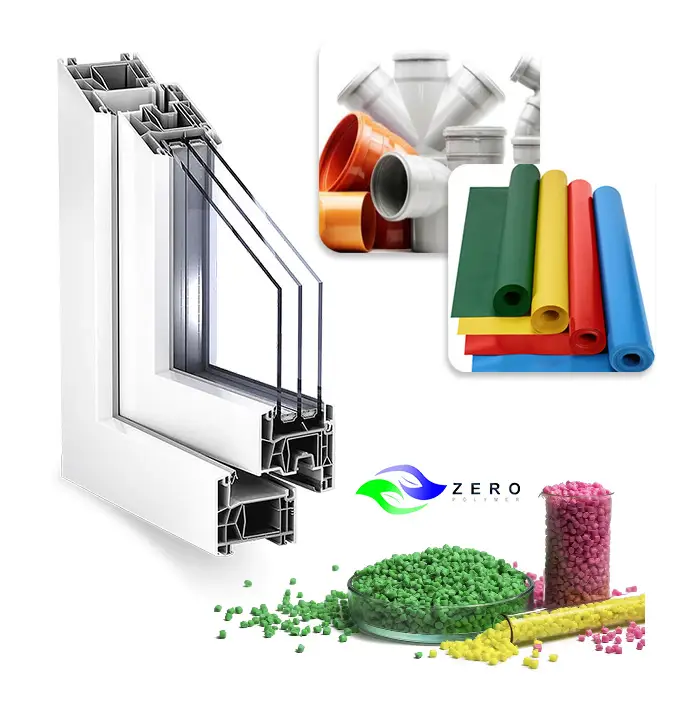
PVC in Various Industries
Polyvinyl chloride (PVC) is a stable and widely used plastic. Producers can recycle and reuse it over times, making it sustainable. PVC is highly recyclable and used in various industries such as automotive, construction, electronics, and clothing due to its physical and chemical properties. It is resistant to heat, flame, corrosion, and atmospheric effects.
Manufacturers use PVC in the production of internal and external parts of cars, fuel pipes, water and sewage pipes, electric cables, windows, doors, and lighting ceilings. They also utilize it in the production of electronic components and fireproof and heat-resistant clothes.
PVC is recognized as a sustainable and green material in the plastic industry due to its recyclability. It is important to note that PVC can be recycled up to 6 or 7 times, and with a product life of 100 years, recycled PVC has the potential to last up to 600 years.
Additionally, PVC has good physical and mechanical properties, and it is resistant to inorganic chemicals, diluted acids, diluted alkalis, and aliphatic hydrocarbons. It is also abrasion-resistant, lightweight, and tough.
PVC is proven to have minimal environmental load in terms of CO2 emission and can contribute significantly to energy efficiency through low thermal conductivity. When considering the global warming issue, PVC is proven as a material with minimal environmental load in terms of CO2 emission, especially when compared with metal or glass products of the same application. Therefore, PVC is a sustainable choice for construction.
PVC History
The history of PVC plastic dates back to 1835 when Henri Victor Regnault, a French chemist, and his student, Justus von Liebig, first synthesized vinyl chloride. In 1913, Friedrich Köhle, a German chemist, succeeded in producing high-quality PVC plastic, known as "Sentaprin," which was used in various industries.
In the 1920s, the BF Goodrich Company was able to produce high-quality PVC plastic on an industrial scale, known as "bakelite," and used in various applications. PVC plastic has since been widely used in industries such as automotive, construction, and electronics due to its physical and chemical properties.
In the 1960s, research was conducted to improve the manufacturing process and the physical and chemical properties of PVC plastic. In the 1970s, environmental issues related to the production and recycling of PVC plastic were investigated due to its high use in various industries.
In the 1980s, further improvements were made in the manufacturing and recycling process of PVC plastic.
PVC Production Methods
The production of PVC plastic is done in two main ways: partial polymerization method and full polymerization method.
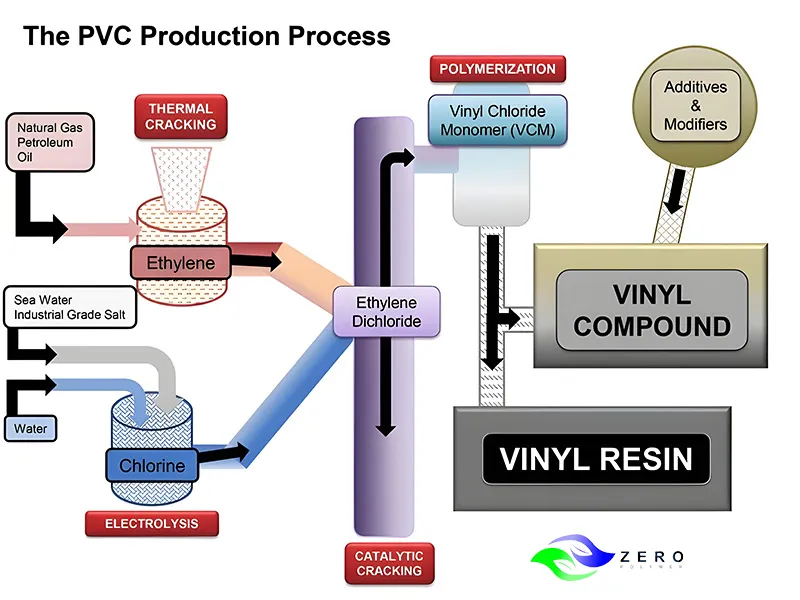
Partial polymerization method
In this method, several vinyl chloride units are attached to several PVC plastic polymer units. This process is done by using a catalyst to intensify the polymerization reaction. In this method, PVC plastic with lower molecular weight and weaker physical properties is produced.
Complete polymerization method
In this method, all vinyl chloride units are connected to each other and a PVC polymer with high molecular weight and better physical properties is produced. This method is done by using a stronger catalyst to intensify the polymerization reaction.
PVC production process
The production process of PVC plastic consists of three main steps: raw unit production, polymerization and forming.
Raw unit production stage
In this step, the chloroaliphatic hydrocarbons are combined and vinyl chloride is produced. Then, vinyl chloride is converted into PVC plastic by partial or complete polymerization.
Polymerization stage
In this step, vinyl chloride is bonded together and PVC plastic is produced. This process is done by using a catalyst to intensify the polymerization reaction.
Forming stage
In this step, the PVC plastic is shaped into various molds. This shaping can be done by heat or pressure.
PVC Recycling Methods
Considering that PVC plastic is one of the most widely used plastics, its recycling is very important. To recycle this material, there are different methods that include mechanical, chemical and thermal methods.
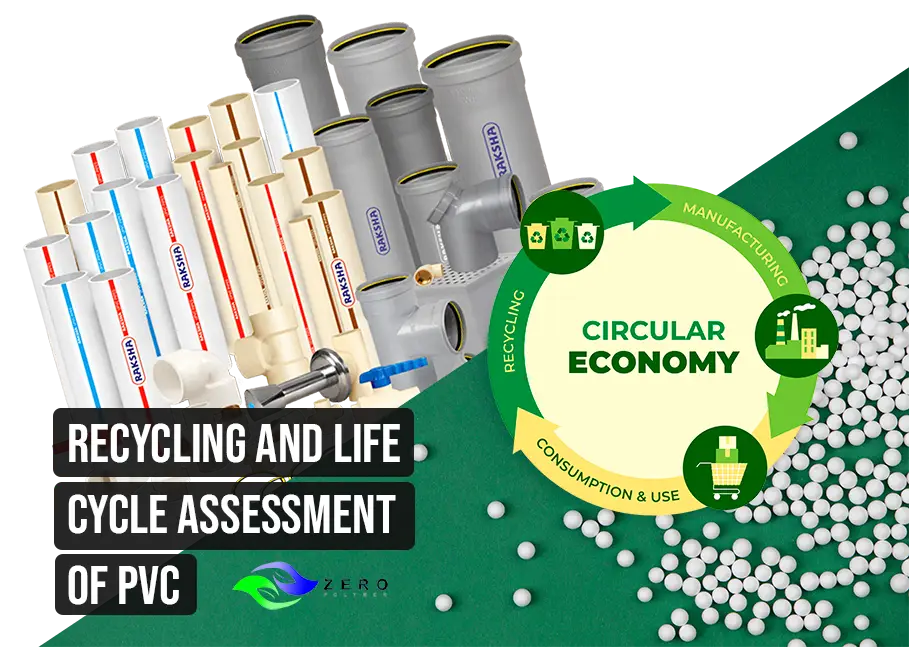
The mechanical recycling method involves breaking and crushing the PVC plastic into smaller pieces. These parts are then used to produce new products.
The chemical recycling method involves the use of chemicals to break down this plastic into raw materials. This method is rarely used due to its high costs.
The thermal recycling method involves breaking down PVC plastic into raw materials using heat. In this method, this material is heated to a high temperature (about 300 degrees Celsius) and turns into raw materials. This method is used more because of its lower costs and efficiency.
Polyvinyl chloride is one of the most widely used plastics in various industries. The production of this plastic is done by two methods of partial and complete polymerization. Considering that PVC plastic is one of the most widely used plastics, its recycling is very important. Recycling methods include mechanical, chemical and thermal methods.
PVC Properties
In this section, the properties of PVC plastic are examined.
Mechanical resistance
PVC plastic has high mechanical resistance. This plastic can withstand pressure and tension. Also, PVC plastic has resistance to corrosion and wear.
Thermal resistance
PVC plastic has high thermal resistance. This plastic can withstand high temperature and is malleable at high temperature.
Chemical resistance
PVC plastic has high chemical resistance. This plastic can withstand all acids, bases, water and concentrated acids.
Processing capability
PVC plastic is easy to process. This plastic is easily molded using different methods such as heat, pressure, etc.
Ability to recycle
PVC plastic is highly recyclable. This plastic is easily recycled using different methods such as mechanical, chemical and thermal recycling.
Attractive appearance
PVC plastic has an attractive and matte appearance. This plastic is used in various industries such as construction and clothing due to its attractive and matte appearance.
Ability to print
PVC plastic has a high printing ability. This plastic is easily printed using different printing methods such as screen printing and offset printing.
Ability to paint
PVC plastic has a high coloring ability. This plastic is easily painted using different colors.
Ability to absorb sound
PVC plastic has the ability to absorb sound. This plastic is used in various industries such as construction due to its high sound absorbing ability.
Ability to be insulated
PVC plastic has a high insulating ability. This plastic is used in various industries such as electronics due to its high insulating ability.

Electrical characteristics
High electrical resistance: PVC has high electrical resistance, which is used as an electrical insulator in various industries such as electronics and electrical industry.
Low water absorption: PVC has low water absorption, which makes it highly resistant to moisture.
Resistance to UV rays: PVC has a high resistance to UV rays, which is used as one of its important features in the construction industry.
Chemical properties
Corrosion resistance: PVC has a high resistance to corrosion, which is used as one of its important features in the chemical industry and refineries.
Resistance to organic solvents: PVC has a high resistance to organic solvents, which is used as an insulator in the chemical industry and refineries.
Ability to withstand acid and base: PVC has the ability to withstand acid and base, which is used as an insulator in the chemical industry and refineries.
Thermal characteristics
Heat resistance: PVC has high heat resistance and is malleable at high temperatures.
Thermal stability: PVC has high thermal stability, which makes it not change its appearance due to temperature changes.
Physical characteristics
Mechanical resistance: PVC has high mechanical resistance, which is used as one of its important features in the automotive and construction industries.
Processability: PVC is easy to process and can be easily molded using various methods such as heat, pressure, etc.
Recyclability: PVC has high recyclability and can be easily recycled using different methods such as mechanical, chemical and thermal recycling.
Attractive appearance: PVC has an attractive and matte appearance, which is used in various industries such as construction and clothing due to its attractive and matte appearance.
Printability: PVC has high printability and is easily printed using different printing methods such as screen printing and offset printing.
Dye ability: PVC has high dye ability and can be easily dyed using different colors.
Sound absorption ability: PVC has sound absorption ability, which is used in various industries such as construction due to its high sound absorption ability.
Insulating ability: PVC has a high insulating ability, which is used in various industries such as electronics due to its high insulating ability.
Diverse Applications of PVC Across Industries
PVC is a versatile material that finds diverse applications across various industries. Its unique properties make it a preferred choice in construction, healthcare, electronics, automotive, and sport, among others. Let's explore some of the key applications of PVC in different sectors.

PVC in Construction:
From Window Frames to Roofing
PVC is a vital material in the construction industry, with numerous applications. Some of them are window frames, door frames, roofing, and cladding. Its versatility and durability make it an ideal choice for both interior and exterior construction projects.
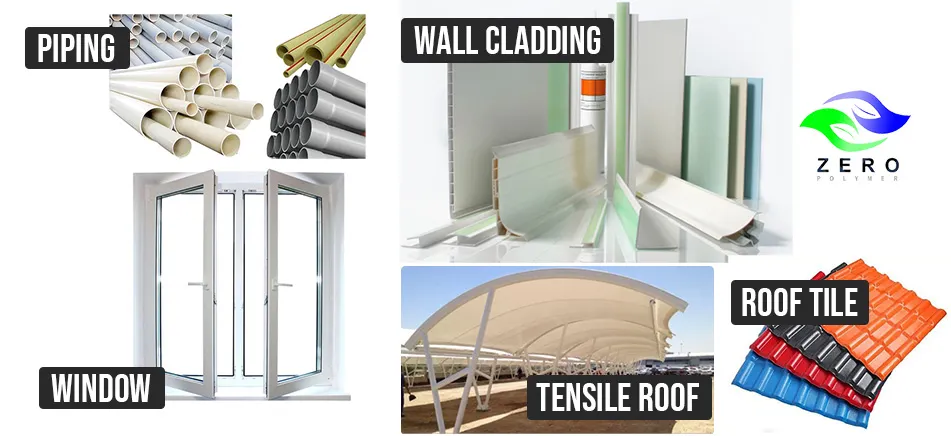
Windows frame applications
In construction, companies prefer PVC in window frames. Because it has an excellent insulation property, resistance to weathering, and low maintenance requirements. PVC frames offer energy efficiency by preventing heat loss or gain, enhancing the overall energy performance of buildings. Additionally, PVC window frames have high sound insulation capabilities. That promotes a quiet and comfortable indoor environment.
Roofing applications
PVC is also a favorable material in roofing applications. It provides excellent resistance to UV radiation, weathering, and chemical degradation. PVC roofing membranes offer superior durability, flexibility, and waterproofing properties, making them suitable for various roofing systems. Companies utilize PVC roofing in commercial, industrial, and residential buildings. Since it offers long-term protection against water infiltration and environmental factors.
Door frame and cladding applications
Furthermore, many companies utilize PVC in door frames, cladding, wall panel and other construction applications. Owing to its lightweight nature, easy installation, and resistance to moisture, termites, and rot. These attributes contribute to the longevity and sustainability of PVC building components.
Piping systems and construction
PVC, or polyvinyl chloride, is widely used in piping and construction due to its various beneficial properties. In piping, constructors utilize PVC for transporting drinking water, drainage solutions, and advanced fire-sprinkler systems. Its smooth surface reduces pumping costs and energy use. While leak-free fittings eliminate water loss, making it an environmentally friendly and cost-effective choice for piping systems.
PVC is also employed in sewer and wastewater conveyance, as well as in drains, vents, and waste handling and control within structures and equipment.
Its resistance to weathering, corrosion, and decay makes it an excellent choice for exterior applications, such as fascia boards and soffit boards.
PVC in Healthcare:
From Life-Saving Devices to Innovations
Polyvinyl Chloride (PVC) is a versatile and cost-effective material that finds extensive usage in the healthcare industry. Owing to its durability, chemical resistance, and biocompatibility. The medical field widely employs PVC in various medical devices. That has played a pivotal role in transforming healthcare delivery over recent decades.
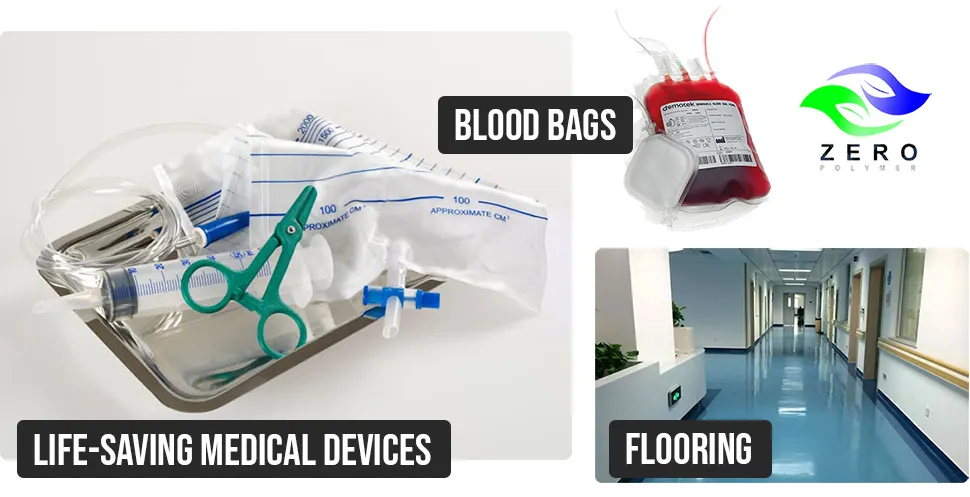
PVC in Life-Saving Medical Devices
PVC is the material of choice for a range of life-saving medical devices, especially blood bags, due to its high biocompatibility and hemocompatibility. It is used to make tubing, oxygen masks, containers for IV and dialysis fluids, IV sets, nasal cannulas, overshoes, examination and surgical gloves, blood vessels for artificial kidneys, blister packaging, mattress covers, and training manikins.
PVC has excellent chemical stability and is compatible with virtually all pharmaceutical products in healthcare facilities today. It also has excellent water and chemical resistance, helping to keep solutions sterile. PVC medical devices can be easily sterilized via steam, autoclave, radiation (electron beam or gamma rays), or ethylene oxide methods, maintaining their key properties such as resistance to scratches and kinks.
Innovations in PVC for Healthcare
Innovations in PVC are helping to improve patient experience and safety in hospitals. Antimicrobial additives can now be bound into the PVC, which, along with excellent cleaning and disinfection practices, can reduce the prevalence of Hospital-Acquired Infections (HAIs). Aesthetic innovations in PVC are also improving the patient experience in hospitals, with the ability to include almost any color, pattern, or shape in a PVC design.
PVC has long been known as a hard-wearing product, which is easy to clean. Its resistance to knocks and scratches makes it ideal for wall coverings in high traffic areas like hospitals. PVC flooring has the added advantage of being shock absorbent, making it comfortable to walk on, and its anti-static properties protect people and sensitive electronic equipment from static.
PVC and Sustainability in Healthcare
Polyvinyl chloride (PVC) is not only versatile and cost-effective but also contributes to sustainability in healthcare. PVC can be recycled 8 to 10 times without loss of functional properties, and several countries have established PVC recycling programs in partnership with medical care facilities. The VinylPlus® Med partnership, for example, gathers hospitals, waste managers, recyclers, and the PVC industry to accelerate sustainability in healthcare.
The global medical PVC plastic market is projected to experience significant growth in the coming years, driven by increasing demand for PVC in medical applications, growing healthcare infrastructure, rising geriatric population, and technological advancements in medical devices.
PVC in Electronics, Automotive, and Sport: A Versatile Player
Polyvinyl Chloride (PVC) is a versatile and cost-effective material that has found extensive applications in various industries, including electronics, automotive, and sports. Because it has unique properties such as durability, chemical resistance, and electrical insulation.
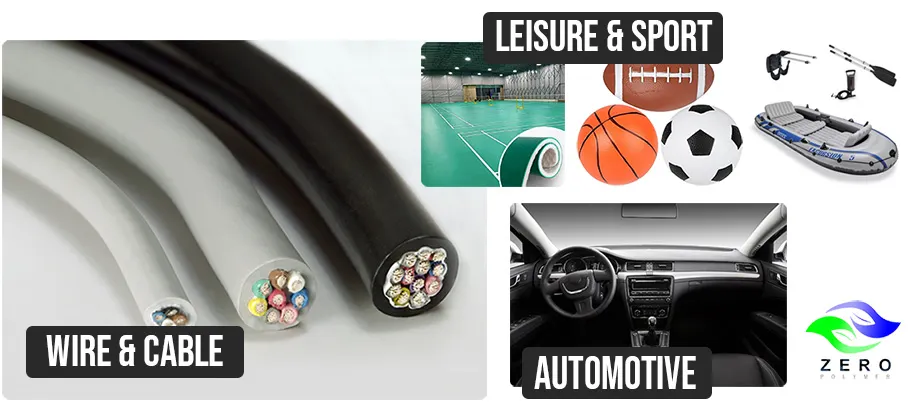
PVC in Electronics
In the electronics industry, manufacturers can massively utilize PVC in cable insulation due to its toughness, resistance to abrasion, and decent mechanical strength. It provides excellent electrical insulation properties, which is crucial in preventing electrical shorts between the Printed Circuit Board (PCB) and the surrounding components or chassis. PVC wires and cables are extremely durable and versatile, resistant to UV, acids, alkalis, oils, and many corrosive substances. This makes them ideal for various applications, including those that require exposure to harsh environmental conditions.
PVC in Automotive
PVC plays a significant role in the automotive industry, contributing to vehicle performance, efficiency, and safety. Producers use it in underbody coatings, sealants, wire harnesses, synthetic leather for seats, passenger compartment parts, and small exterior trims. PVC's use in vehicles contributes to reducing the weight and increasing the fuel efficiency of modern cars.
PVC is also important in shock-absorbing vehicle components such as 'soft' dashboards, reducing injury in the case of impact. Producers use fabrics coated with PVC in life-saving vehicle airbags, while the fire-retardant properties of the material contribute to the overall safety of a vehicle.
The use of PVC in the automotive industry is not only cost-effective but also environmentally sound. It helps to make vehicles more affordable, and its lightweight nature helps to reduce the overall weight of any vehicle, which in turn, lowers wear and tear on the roads, and can decrease fuel consumption.
PVC in Sports
In the world of sports, PVC's durability, longevity, and ability to withstand considerable physical stress make it a popular choice for various applications. It finds uses in the construction of sporting venues, including flooring, roofing, piping, and seating.
PVC is also a favorable material in sports equipment and protective gear. Companies use PVC in the production of tennis nets, floors of gyms and playgrounds, balls, bags, mats, boxing gloves, clothing, footwear, and more. It is also important in the construction of stadiums and sports centers, providing a combination of architectural freedom with environmental responsibility.
PVC sports surfaces are popular for indoor sports facilities and stadiums due to their good quality, durability, and ability to withstand a lot of pressure. Companies benefit from PVC for various sports including racquet sports, table tennis, indoor football, basketball, and volleyball.
Safety Concerns of PVC
PVC plastic is one of the long-established plastics in various industries. However, there are some safety concerns. These concerns include toxicity, the possibility of fire, environmental effects, effects on workers' health, and risks for children. While PVC is a common plastic in various industries, it can pose risks to human health and the environment. However, by following safety standards, using safer alternative materials, and recycling PVC, these risks can be minimized.
Toxicity: PVC's toxicity is a concern due to materials like phthalates, which can increase the risk of cancer and hormonal disorders. The use of phthalates in PVC production has been drastically reduced, and safer alternatives are now used.
Possibility of fire: PVC is flammable due to the presence of chlorine, but this risk can be minimized by using the right raw materials and following safety standards.
Environmental effects: Improper disposal of PVC can have harmful effects on the environment, but this problem can be solved by using PVC recycling and reuse processes.
Effects on workers' health: Workers in industries using PVC may face risks, but these risks can be minimized by following safety standards and using safety equipment.
Risks for children: Some PVC products may pose risks to children, but these risks can be minimized by using the right materials and following safety standards.
The use of PVC can be safe and efficient in various industries, provided that safety standards are met and safer alternative materials are used.
The Advantages and Disadvantages of PVC
In industries, PVC offers numerous advantages alongside a few disadvantages. Let's explore them.
What Are the Key Advantages of PVC?
Durability: PVC is resistant to weathering, chemical rotting, corrosion, shock, and abrasion.
Electrical insulation: PVC has excellent dielectric strength, making it a popular choice for electric cables.
Chemical resistance: PVC is resistant to a wide range of chemicals, including oils, acids, and alkalis.
Flame retardancy: PVC is self-extinguishing due to its high chlorine content.
Cost-effectiveness: PVC is an affordable and economical solution compared to other materials.
Lightweight: PVC is lightweight, making it easier to handle and install.
Easy to set up: Manufacturers can cut, shape, weld, and join the PVC quickly in a variety of designs.
Resilient: PVC is resistant to weathering, rotting, chemical deterioration, shock, and abrasion.
Environmental impact: Manufacturers can recycle and reuse PVC, which helps minimize waste.
Energy efficiency: The production of PVC is energy efficient, using less energy and fewer resources compared to some other materials.
Long service life: PVC pipes have a proven performance record of over 50 years.
Reduced failures and blockages: The smooth lining of PVC pipes reduces water flow resistance and prevents build-up in sewage and wastewater systems.
Quicker installation time: Companies can install PVC pipes faster than other materials, which saves time and reduces labor costs.
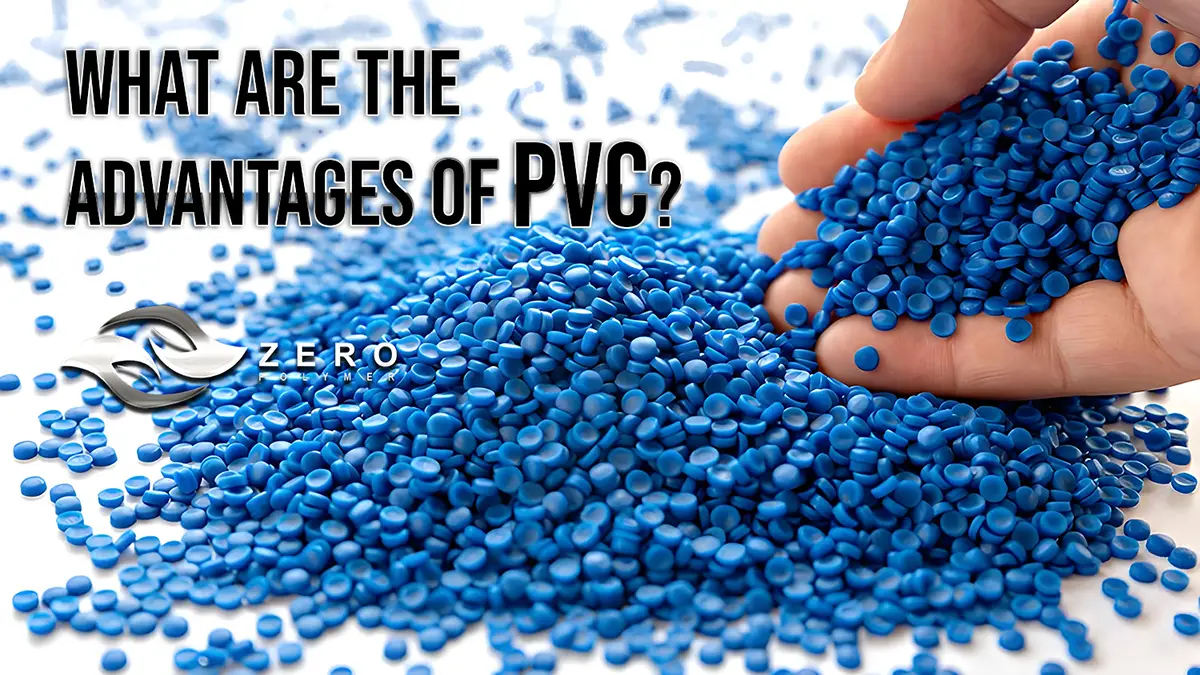
PVC Disadvantages
Environmental vulnerability: PVC has environmental vulnerability in the production and recycling process and may lead to air, water and soil pollution.
Contains phthalates: PVC contains phthalates, which may be harmful to public health.
Flammable: PVC is flammable and may catch fire if exposed to heat or flame.
Weakness against UV: PVC is weak against UV light and may change color over time.
PVC Market
In 2020, the PVC market exceeded 40 million tons and nearly reached 60 billion dollars. The PVC market is expected to continue growing in 2021 and beyond. Based on the construction industry's expansion, experts estimate that the PVC market will surpass 50 billion dollars by 2028, with a high growth rate anticipated.
Several factors, such as the construction industry's growth, increased automobile production, expansion of the electronics industry, and technological advancements across various sectors, drive the PVC market's growth. Additionally, the rise in plastic production and usage in developing countries contributes to the market's expansion.
Despite concerns about the safety and environmental impact of PVC plastic affecting the market, addressing these concerns involves recognizing the use of safer alternative materials and compliance with safety standards as appropriate solutions.
The PVC market will persistently grow in the coming years due to the expansion of various industries and the demand for widely used plastics like PVC. Nevertheless, emphasizing compliance with safety standards and developing safer alternative materials remains crucial to safeguarding the health of people and the environment.
PVC plastic stands out as one of the world's most widely used plastics. Its unique characteristics, including resistance to weather conditions, UV rays, heat, and acids, make PVC indispensable in various industries such as construction, automotive, packaging, electronics, household appliances, and medicine.
PVC Consumption in Various Industries
Recent statistics indicate that the production of PVC reached about 62 million tons in 2020. The construction industry holds the highest consumption share, accounting for approximately 60% of the total PVC consumption. Within this industry, PVC finds application in manufacturing water pipes, windows, doors, floors, and ceilings.
In the automotive sector, PVC serves as a primary component in producing car interior parts, including dashboards, floor coverings, seats, and doors. The consumption of PVC in this industry contributes to around 15% of the total PVC consumption.
The packaging industry utilizes PVC as a soft and transparent plastic to manufacture packaging for various products such as food, medicine, and cosmetics. Approximately 10% of the total PVC consumption is attributed to this industry.
In the electronics sector, PVC acts as a plastic with electrical insulation properties, employed in the production of electrical and electronic cables. The consumption of PVC in this industry makes up about 5% of the total PVC consumption.
The medical industry employs PVC for producing medical products like blood tubes, feeding tubes, breathing tubes, and medical gloves, leveraging its specific physical and chemical properties. PVC consumption in this sector constitutes about 5% of the total PVC consumption.
Despite PVC's widespread use in various industries, concerns related to the environment and health hinder its continued utilization. Consequently, there is a recognition of the need to replace PVC with safer alternative materials across different industries.
PVC Export Statistics in the World
According to the World Trade Organization, in 2020 PVC export exceeded its import worldwide with a much higher rate of production. Statistics that have been published show that PVC production in 2020 was around 62 million tons.
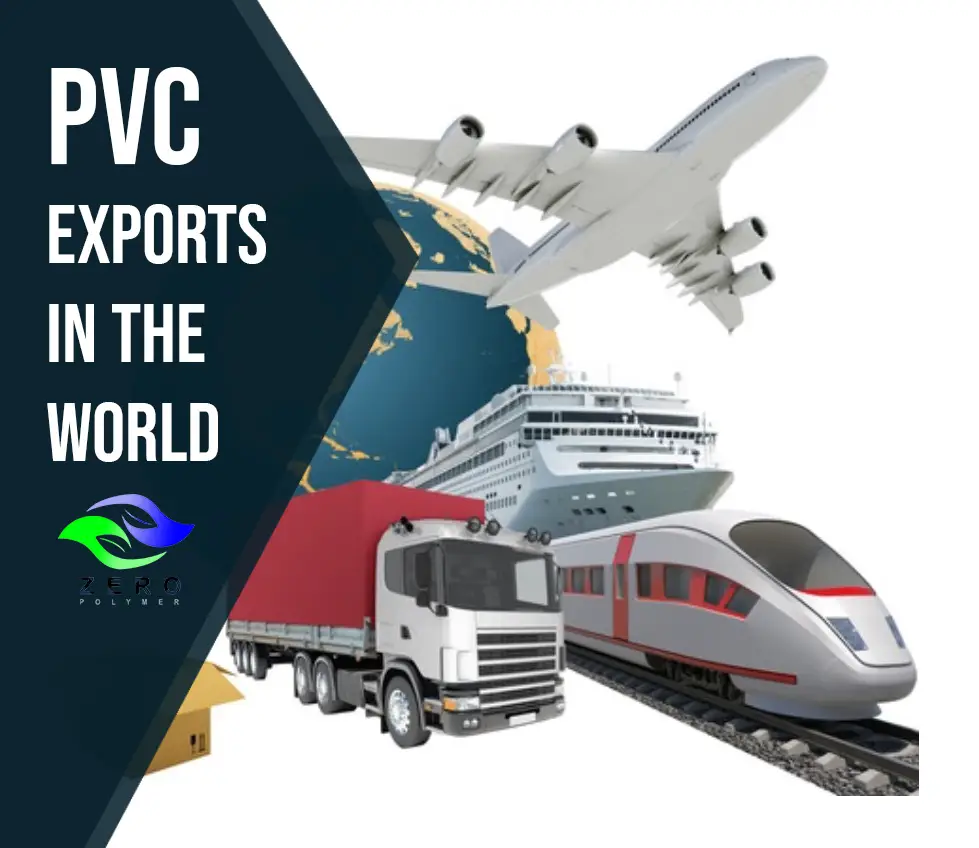
PVC is mostly exported to Asian countries such as China, India, Vietnam, South Korea and Thailand. China, however, is the leader in terms of exports to other countries. Next in line are India, Vietnam, and South Korea with high export figures for PVC.
Other countries in Europe, including Germany, France, Italy and Spain import PVC. Data shows that these countries are among the largest importers of PVC.
As a result, exports of PVC were approximately 20 million tons in the year 2020. This figure shows that PVC is still widely used within different industries around the world despite environmental and health concerns.
The world’s PVC export data indicates that the use of this plastic in various industries is still being considered as an economical and functional option. Nevertheless, taking into account environmental and public health concerns, the recognition of a substitution strategy for PVC with safer alternative materials in several industries as an appropriate solution has been supported.
PVC Export Statistics in Iran
Statistics of the Iran Industry, Mining, and Trade Organization for 2020-21 show that PVC was exported to countries like Iraq, Afghanistan Turkmenistan Qatar UAE. As stated in the published data, Iraq tops the countries exporting PVC to foreign nations on a large scale. Afghanistan, Turkmenistan and Qatar are close behind with significant quantities of PVC exports.
Besides neighboring countries, Iran has also exported PVC to European nations. Spain, France and Italy are pointed out as countries that have imported large quantities of PVC from Iran.
Overall, in 2019, Iran’s PVC exports amounted to around 155 thousand tons. Figure 1 shows that PVC is widely used in different sectors of Iran.
Looking at PVC export statistics in Iran, it can be seen that the use of this plastic material for various industries in the country is considered an economic and practical solution. Nevertheless, addressing the environmental and public health concerns, initiatives to replace PVC with safer alternative materials in different industries have been recognized as a viable approach. In particular, the ongoing development of alternatives to PVC in Iran should continue in this direction.
Assessing the quality and durability of PVC products
When choosing PVC granules, it is important to assess their quality and durability. Opting for a product that meets industry standards and has a proven track record of quality can help you save both time and money in the long run.
One effective way to evaluate the quality of these products is by looking into the reputation of the manufacturer. Researching the manufacturer's history and reputation can assist you in determining the reliability of their products. Always look for manufacturers that have a strong industry presence and a track record of producing high-quality products.
The Importance of Product Testing, Certifications, and Warranties
When it comes to choosing the right PVC products, there are some important factors to consider. One of these is product testing and certifications. You should look for products that have been tested for strength, durability, and resistance to various environmental factors. Reputed manufacturers are known for producing high-quality PVC materials that have a long lifespan, and are resistant to aging, weathering, and degradation caused by different chemicals and environmental factors. You can also check for certifications such as ISO 9001 or ASTM standards to ensure that the product is of a high quality and reliable.
In addition, it is important to consider the product's warranty or guarantee. A manufacturer that provides a warranty or guarantee for their product is likely confident in its performance and durability. As well, it's important to provide after-sales support, technical assistance, and responsive customer service.
By taking the time to thoroughly assess the quality of PVC products and the right manufacturer, you can make an informed decision that will result in a long-lasting and reliable solution for your specific needs.
Zero Polymer Polyethylene and PVC Products
At ZPolymer.com, we understand the importance of product testing and certifications. That's why all our PVC products undergo rigorous testing for strength, durability, and resistance to environmental factors.
We offer a comprehensive warranty and guarantee for all our products, reflecting our confidence in their long-term durability and performance.
We are committed to providing excellent PVC raw materials for various applications. By using the latest technology and high-quality raw materials acquired within Iran, we are able to offer cost-effective solutions for overseas buyers.
By concentrating on quality and design capacities, we guarantee that our PVC products are of the best possible quality, making them applicable for use in a number of different industries such as automotive, construction, agriculture and consumer goods. Our dedication to constant innovation and investment in state-of-the-art equipment enables us to produce complex and accurate PVC products that meet worldwide market needs.
Further, our strategic location in Iran provides us with access to the main shipping lanes and markets of Europe, Asia and Africa. This convenience enables us to export our products globally. In addition, we take advantage of the backing of Iranian government’s initiatives to boost exports which also fortifies our ability to provide competitive prices for our PVC products.
We assure to meet customers’ demands by delivering the best PVC products at reasonable prices. To find out more about what we can do for your PVC product needs, contact us today.
YOU MIGHT ALSO LIKE

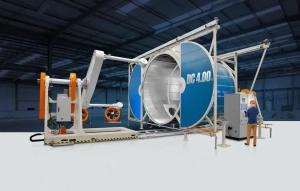
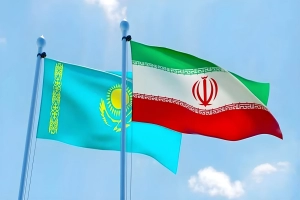
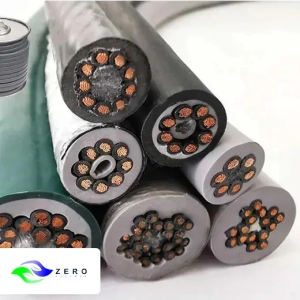
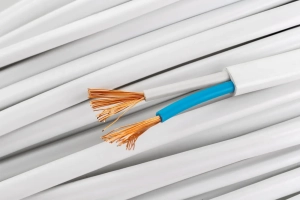
HDPE Cable Jacketing: The Ultimate Protector and Why It Matters
